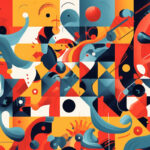Are you interested in web design but don’t know where to start? Or are you already a professional in the field but looking to expand your knowledge and skills? Whatever your level of expertise, having a good reference book is a crucial step towards becoming a successful web designer. In this article, we will introduce you to the 10 best web design books for both beginners and professionals. These books will provide you with the fundamental knowledge, skills, and inspiration needed to create outstanding websites.

Why Web Design Books are Essential for Success
Many web designers today rely on self-learning and online resources to develop their skills. While these resources can be helpful, they are often scattered and incomplete, making it difficult for learners to gain a comprehensive understanding of web design. Web design books, on the other hand, provide a structured and in-depth approach to learning. They cover everything from the basics of HTML and CSS to advanced topics such as responsive design, user experience, and web accessibility. By reading web design books, you can acquire a deeper understanding of the principles and techniques behind web design, which can help you create more effective and visually appealing websites.
The Importance of Learning Web Design Fundamentals
Before diving into the technical aspects of web design, it is essential to learn the fundamentals of the field. This includes understanding the principles of design, color theory, typography, and layout. The first few books on our list are dedicated to teaching these fundamental skills. These books will help beginners get started and ensure that professionals have a solid foundation to build upon.
For example, “The Principles of Beautiful Web Design” by Jason Beaird is a great resource for learning the basics of web design. It covers topics such as layout, color, typography, and imagery in a clear and concise manner. The book also includes practical examples and exercises to help you apply what you’ve learned.
Another essential book for learning web design fundamentals is “HTML and CSS: Design and Build Websites” by Jon Duckett. This book provides a comprehensive introduction to HTML and CSS, with a focus on building responsive and accessible websites. It also includes plenty of visual examples and code snippets to help you understand the concepts.
Staying Updated with Industry Trends and Techniques
Web design is an ever-evolving field, with new trends and techniques emerging all the time. To stay relevant and competitive, it is crucial to keep up with these changes. The later books on our list cover the latest trends in web design, such as responsive design and user experience. These books will help you stay up to date with new techniques and trends, which will allow you to create more innovative and effective websites.
One such book is “Don’t Make Me Think” by Steve Krug, which is a classic in the field of web design. It focuses on user experience and usability, providing practical tips and examples for creating websites that are easy to use and navigate. The book also covers the latest trends in web design, such as mobile-first design and responsive design.
Another great resource for staying updated with industry trends is “Responsive Web Design” by Ethan Marcotte. This book is considered a must-read for anyone interested in responsive design, which is a technique for building websites that adapt to different screen sizes and devices. The book covers the technical aspects of responsive design, as well as best practices and examples.
Enhancing Creativity and Inspiration
Designing outstanding websites not only requires technical skills but also creativity and inspiration. The last few books on our list focus on these aspects of web design. They provide insights and tips on how to enhance your creative thinking, develop unique design concepts, and inspire new ideas. These books will help you break free from common design techniques and create websites that stand out.
“Steal Like an Artist” by Austin Kleon is a book that encourages designers to look for inspiration in unexpected places and to embrace their unique perspectives. The book provides practical advice on how to develop creative habits and overcome creative blocks.
“The Design of Everyday Things” by Don Norman is another book that can help enhance your creative thinking. It focuses on the principles of user-centered design and provides examples of how good design can improve people’s lives. The book also covers topics such as cognitive psychology and human behavior, which can help designers create more effective and intuitive websites.
Overall, web design books are an essential resource for anyone interested in the field. They provide a structured and comprehensive approach to learning, as well as insights and inspiration for creating outstanding websites. Whether you are a beginner or a seasoned professional, there is always something new to learn from a good web design book.
Top 5 Web Design Books for Beginners
HTML and CSS: Design and Build Websites by Jon Duckett
This book is an excellent resource for beginners who want to learn the basics of HTML and CSS. It offers a comprehensive and easy-to-understand introduction to these languages, covering everything from the box model to positioning. The book also includes a variety of visual aids, such as diagrams and code samples, to help learners understand the concepts. With this book, beginners can quickly master the basics of building websites.
You can find this book here.
Learning Web Design: A Beginner’s Guide by Jennifer Niederst Robbins
If you prefer a more interactive and hands-on approach to learning, this book is for you. It includes a series of projects and exercises that allow learners to apply their knowledge and develop practical skills. The book covers basic concepts of web design, including HTML, CSS, and JavaScript, and also delves into more advanced topics such as responsive design and web accessibility. With this book, beginners can build a solid foundation in web design.
You can find this book here.
Don’t Make Me Think: A Common Sense Approach to Web Usability by Steve Krug
Usability is an essential aspect of web design, and this book provides a user-centered approach to designing websites. The book offers practical advice on how to design websites that are user-friendly and intuitive, with a focus on simplicity and clarity. It also covers topics such as navigation design, usability testing, and mobile design. With this book, beginners can learn how to create websites that are easy to use and effective.
You can find this book here.
Web Design with HTML, CSS, JavaScript, and jQuery Set by Jon Duckett
Building on the foundation of the first book on our list, this book set provides a comprehensive guide to web design with HTML, CSS, JavaScript, and jQuery. It covers the entire process of building a website, from design to development, and includes a variety of tips and techniques to enhance the design and functionality of the site. The book set also includes visual aids, such as diagrams and code samples, to help learners understand the concepts. With this book set, beginners can become proficient in web design.
You can find this book here.
The Principles of Beautiful Web Design by Jason Beaird
This book teaches beginners how to create visually appealing websites that are easy to use and navigate. It covers design concepts such as typography, color theory, and layout, and also includes practical advice on how to create effective visual hierarchy and user-friendly interfaces. The book also includes code samples and real-world examples to illustrate the concepts. With this book, beginners can create websites that are not only functional but also visually stunning.
You can find this book here.
Top 4 Web Design Books for Professionals
Responsive Web Design with HTML5 and CSS by Ben Frain
Responsive design is a crucial aspect of modern web design. This book provides a comprehensive guide to building responsive websites using HTML5 and CSS. It covers topics such as fluid grids, media queries, and flexible images, and also includes practical advice on how to test and optimize for different devices. With this book, professionals can create websites that adapt to different screen sizes and provide an optimal user experience.
You can find this book here.
Designing with the Mind in Mind: Simple Guide to Understanding User Interface Design Guidelines by Jeff Johnson
This book focuses on designing interfaces that are intuitive and easy to use. It provides a comprehensive overview of the principles of cognitive psychology, and how they can be applied to interface design. The book covers topics such as visual perception, attention, memory, and decision-making, and offers practical advice on how to design interfaces that are user-friendly and effective. With this book, professionals can take their design skills to the next level and create interfaces that are not only visually appealing but also easy to use.
You can find this book here.
CSS Secrets: Better Solutions to Everyday Web Design Problems by Lea Verou
This book is a collection of practical CSS solutions to common web design problems. It covers advanced CSS techniques such as gradients, transformations, and animations, as well as practical advice on how to organize and optimize CSS stylesheets. The book also includes real-world examples and code snippets to illustrate the concepts. With this book, professionals can improve the efficiency and effectiveness of their CSS coding.
You can find this book here.
UX for Web Designers by Laura Klein
User experience (UX) is a critical aspect of web design, and this book provides a practical guide to designing websites with user-centric approaches. The book covers topics such as user research, design thinking, and prototyping, and also includes practical advice on how to test and validate designs. The book also includes real-world case studies and examples to illustrate the concepts. With this book, professionals can create websites that provide a seamless and enjoyable user experience.
Atomic Design by Brad Frost
This book offers a unique approach to web design by breaking it down into small, reusable parts that can be easily combined to create a whole. It covers the concept of atomic design, which involves creating design systems that are consistent and scalable. The book also includes practical advice on how to implement atomic design in practice, with code examples and case studies. With this book, professionals can create more consistent and efficient design systems.
You can find this book here.
Conclusion
Web design is a complex and ever-evolving field, but with the right resources, it can be mastered. The 10 books on our list provide a comprehensive and in-depth approach to web design, covering everything from basics to advanced topics, as well as providing practical advice on how to improve creativity and inspiration. Whether you are a beginner or a professional, these books are essential resources for advancing your web design skills.
- The 11 Best Books About Cats You Should Read - January 16, 2024
- The 9 Best Books on Building Confidence - January 16, 2024
- Discover the 10 Best Books on the Brain - January 16, 2024








